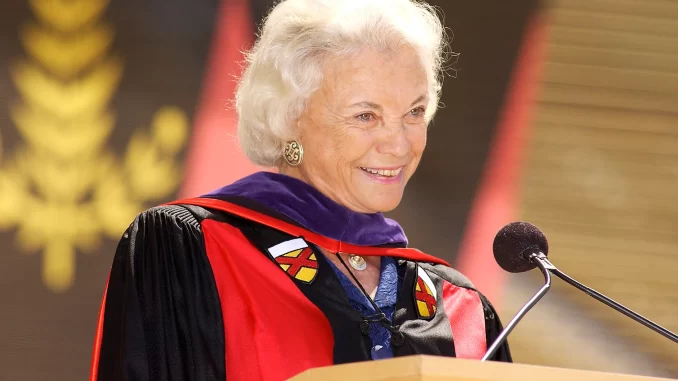
Retired Supreme Court Justice Sandra Day O’Connor, the first woman to serve on the country’s high court and started her law career in San Mateo County after graduating from Stanford Law School, died today at age 93.
O’Connor died in Phoenix, of complications related to advanced dementia and a respiratory illness, the Supreme Court said in a news release.
Chief Justice John Roberts mourned her death. “A daughter of the American Southwest, Sandra Day O’Connor blazed an historic trail as our Nation’s first female Justice,” Roberts said in statement issued by the court. “She met that challenge with undaunted determination, indisputable ability, and engaging candor.”
In 2018, she announced that she had been diagnosed with “the beginning stages of dementia, probably Alzheimer’s disease.” Her husband, John O’Connor, died of complications of Alzheimer’s in 2009.
O’Connor’s nomination in 1981 by President Ronald Reagan and subsequent confirmation by the Senate ended 191 years of male exclusivity on the high court. A native of Arizona who grew up on her family’s sprawling ranch, O’Connor wasted little time building a reputation as a hard worker who wielded considerable political clout on the nine-member court.
On the bench, her influence could best be seen, and her legal thinking most closely scrutinized, in the court’s rulings on abortion, perhaps the most contentious and divisive issue the justices faced. O’Connor balked at letting states outlaw most abortions, refusing in 1989 to join four other justices who were ready to reverse the landmark 1973 Roe v. Wade decision that said women have a constitutional right to abortion.
Then, in 1992, she helped forge and lead a five-justice majority that reaffirmed the core holding of the 1973 ruling. “Some of us as individuals find abortion offensive to our most basic principles of morality, but that can’t control our decision,” O’Connor said in court, reading a summary of the decision in Planned Parenthood v. Casey. “Our obligation is to define the liberty of all, not to mandate our own moral code.”
Thirty years after that decision, a more conservative court did overturn Roe and Casey, and the opinion was written by the man who took her high court seat, Justice Samuel Alito. He joined the court upon O’Connor’s retirement in 2006, chosen by President George W. Bush.
O’Connor was 51 when she joined the court to replace the retired Potter Stewart. A virtual unknown on the national scene until her appointment, she had served as an Arizona state judge and before that as a member of her state’s Legislature.
The woman who climbed higher in the legal profession than had any other woman did not begin her career auspiciously. As a top-ranked graduate of Stanford’s prestigious law school, class of 1952, O’Connor discovered that most large law firms did not hire women.
One Los Angeles firm offered her a job as a secretary.
She ultimately got her start at the San Mateo County District Attorney’s Office, where then Assistant District Attorney Keith Sorenson hired O’Connor after she sent a letter to the office asking to be hired. Sorenson hired her and she worked out of the DA’s Redwood City offices until she and her husband moved to Arizona.
Perhaps it was that early experience that shaped O’Connor’s professional tenacity. While workweeks typically stretched to 60 hours or more, she found time to play tennis and golf. Before her husband developed Alzheimer’s, they danced expertly and made frequent appearances on the Washington party circuit.
O’Connor’s survivors include her three sons, Scott, Brian and Jay, six grandchildren and a brother.
-from staff and wire reports.
Pick up tomorrow’s Post for more about Justice O’Connor’s ties to the Mid-Peninsula.
